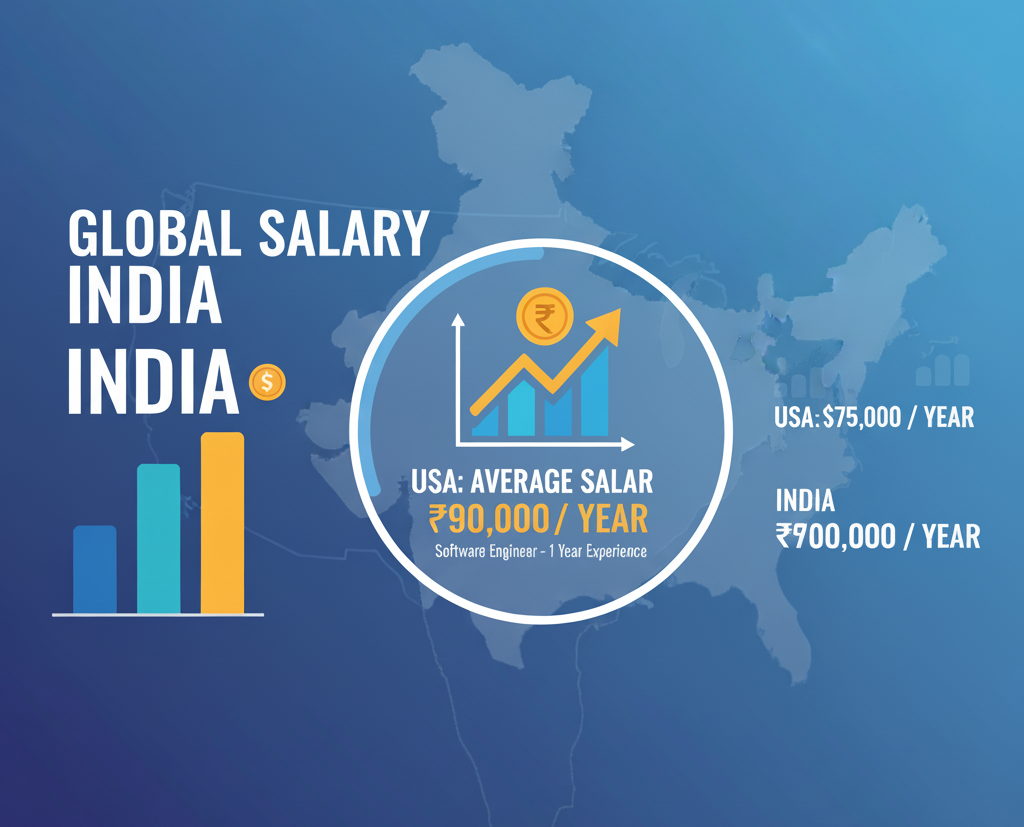Introduction: The Global Paycheck Perspective
In an increasingly connected world, geography still plays a massive role in determining how much you earn. As remote work blurs borders and global hiring becomes more common, understanding international salary USA vs UK vs India differences has never been more relevant. Many professionals today compare pay scales across major economies like the USA, UK, and India to evaluate career moves, remote job opportunities, or global mobility options.
However, comparing salaries is not as simple as looking at numbers. Cost of living, taxation, skill demand, and exchange rates all influence real income. For example, while a U.S. tech engineer might earn triple the salary of an Indian counterpart, their disposable income might not be three times higher due to taxes and expenses.
This global salary comparison (USA vs UK vs India) breaks down average wages, living standards, and job market realities in 2025. Whether you’re a remote worker, global job seeker, or HR professional planning to hire internationally, these insights will help you understand how far your paycheck can really go.
The U.S. Job Market: High Salaries, High Costs
Earning Potential in the Land of Opportunity
The United States remains one of the most lucrative job markets globally. With an average annual salary of around $60,000–$70,000, American workers generally enjoy higher pay compared to other regions. In technology, finance, USA vs UK vs India and healthcare sectors, professionals can earn significantly more. For instance, software engineers earn between $100,000 and $140,000 per year in major hubs like San Francisco, New York, and Seattle.
The reason behind these high wages lies in a combination of innovation-driven industries, advanced infrastructure, and competitive labor markets. American companies invest heavily in attracting top talent through generous compensation, benefits, and stock options.
The Cost of Living Trade-Off
However, higher earnings often come with higher living costs. Cities like San Francisco, New York, and Los Angeles rank among the most expensive in the world. The average rent for a one-bedroom apartment can exceed $3,000 per month, and healthcare expenses are substantially higher than in other countries.
Thus, while nominal salaries are impressive, real purchasing power varies widely. Workers in smaller cities or remote roles often retain a greater portion of their income due to lower living expenses.
Taxation and Disposable Income
U.S. income tax rates range from 10% to 37%, depending on income USA vs UK vs India brackets and states. Additionally, social security and Medicare deductions reduce take-home pay. Still, the U.S. offers strong career mobility and entrepreneurial opportunities, which continue to make it a top choice for ambitious professionals worldwide.
The UK Job Market: Stability Meets Modest Pay
Average Salaries Across Sectors
In the United Kingdom, the average annual salary stands around £35,000–£45,000, translating to roughly $45,000–$55,000. Major cities like London, Manchester, and Edinburgh attract skilled workers from across Europe and beyond, especially in technology, finance, and creative industries.
For comparison, a mid-level software engineer in London earns between £50,000 and £70,000, while professionals in banking or consulting can earn up to £100,000 or more annually. However, entry-level roles or non-technical positions often pay significantly less.
Balancing Pay and Living Costs
While the UK’s cost of living is lower than the U.S. in some areas, London remains expensive. Rent, transport, and energy costs have surged post-pandemic, reducing disposable income for many professionals. Cities outside London, such as Birmingham or Leeds, offer better value for money, with more affordable housing and comparable salaries in growing industries.
The Tax Perspective
The UK tax system is progressive, with rates from 20% to 45% on income. Additionally, the National Insurance contributions reduce net earnings. However, the public healthcare system (NHS) offsets private medical costs that USA vs UK vs India burden U.S. workers. This balance between taxes and social benefits creates a sense of financial security for many British employees, even if the nominal salary is lower than that in the U.S.
Remote Work and Flexibility
Post-Brexit, the UK has also embraced hybrid and remote work models, making it easier for professionals to work from smaller towns or even abroad while retaining London-based salaries. This has improved overall work-life balance and quality of living for many employees.
The Indian Job Market: Growth, Opportunity, and Value
Rapidly Evolving Salary Landscape
In India, the average annual salary is approximately ₹6–8 lakhs ($7,000–$9,000). However, this figure varies greatly depending on industry and experience. Tech professionals, especially in software development, data science, and product management, earn far more often ₹15–25 lakhs ($18,000–$30,000) annually at leading firms or MNCs.
India’s strength lies in its value-to-cost ratio for global employers. Companies hiring Indian talent benefit from lower labor costs, while professionals enjoy strong purchasing power due to a relatively affordable lifestyle.
Cost of Living Advantage
Housing, transportation, and groceries in India are far USA vs UK vs India cheaper than in Western countries. A professional earning ₹15 lakhs in Bengaluru or Pune can maintain a comfortable lifestyle, equivalent to someone earning around $80,000–$100,000 in the U.S. when adjusted for cost of living.
However, income inequality remains a challenge. The wage gap between sectors, such as IT versus manufacturing or education, is significant. Additionally, inflation and currency fluctuations can affect real income over time.
Taxation and Economic Factors
India’s income tax rates range from 5% to 30%, depending on the income bracket. Despite these deductions, employees benefit from relatively lower daily expenses, affordable healthcare, and strong family support systems, which contribute to higher savings rates compared to Western countries.
The Remote Work Boom
The post-pandemic surge in remote global hiring has benefited Indian professionals immensely. Many now earn in dollars or pounds while living in India, multiplying their real income. This trend has led to a new class of “digital expats,” Indian workers contributing to global teams while enjoying a lower cost of living at home.
Purchasing Power Parity (PPP) and Lifestyle
Pure salary comparison often overlooks purchasing power parity (PPP) how much your income can actually buy in your local economy. On a PPP basis, Indian professionals often enjoy similar living standards to mid-level Western workers despite earning less in absolute terms.
For instance, a U.S. worker might spend 35–40% of their income on rent, while an Indian remote worker might spend only 10–15%, freeing up more for savings or investments.
Skill Premium and Industry Gaps
High-tech industries, particularly AI, cloud computing, and data analytics, show narrowing gaps between India and Western markets due to global hiring. Remote roles have made skills, not location, the new currency of employment. A skilled developer in India can now command near-parity pay if employed by global companies.
Global Hiring and Pay Equity
As remote work continues to evolve, employers are reassessing how they pay international teams. Some firms are shifting toward location-neutral pay models, while others still adjust salaries based on regional economics. The coming years may witness a more equitable global pay structure, where skill and performance matter more than geography.
Conclusion: The Future of Global Pay Is Borderless
The global salary comparison between the USA, UK, and India highlights a complex but fascinating reality, while the U.S. leads in nominal pay, India offers unmatched value in terms of living standards and savings potential. The UK sits comfortably in between, offering stability, benefits, and quality of life despite modest wages.
As 2025 unfolds, salary comparisons will increasingly USA vs UK vs India depend on remote work dynamics, AI-driven productivity, and global talent mobility. The gap between developed and emerging economies is gradually narrowing, driven by digital connectivity and flexible work structures.
For professionals, this means opportunity. Whether you’re aiming for a Silicon Valley paycheck, a London work-life balance, or an Indian startup’s fast-paced growth, understanding these salary trends helps you plan your career and finances smarter.
In the new world of work, global pay is no longer about where you live; it’s about what you bring to the table.
Find Your Dream Job Today. Explore Endless Career Opportunities and Secure Your Next Role with the Best Job Tool







Leave a Reply